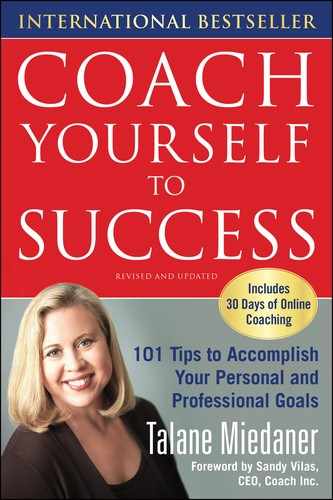TIP 36
DO ONE THING AT A TIME
Grasp all, lose all.
Rushing around, trying to do 10 things at once is not efficient. Give yourself permission to do one thing at a time. In reality, that’s all you can do. This may be hard, but you might as well accept it and focus on doing one thing consciously and well. I hear you already protesting that you not only can do multiple tasks at once but that you have to—you work in a busy and stressful office.
So, let’s take a look at a typical busy day. You are working on a report, and the phone rings. You answer the phone while still looking at the report. You are talking on the phone and looking at the report when someone comes up to interrupt you. Now you are doing three things at once—a normal day at the office. No wonder you feel exhausted at the end of the day.
Now imagine the same situation in slow motion. You are working on the report, the phone rings, you stop working on the report and pick up the phone. You start a phone conversation. Now when someone comes in with a question, you have a choice. Either you stop the phone conversation, “Could you please hold?” and start a new conversation, or you stop the interruption, complete your phone conversation, hang up, and start the new conversation. Next, you stop that conversation, and then you start your report again.
Your life is a series of starts, changes, stops. Since you really can do only one thing at a time, just do one thing at a time consciously and deliberately instead of pretending that you are doing three things at once. It is wonderfully liberating. When I consciously did one thing at a time at the office, I felt in control instead of overwhelmed and flustered. It is obviously stressful to try to do more than one thing at a time, and there is nothing attractive about stressed-out people. You will miss great opportunities if you are too busy to see them.
This week make a point of only doing one thing at a time.
Lauren, a very busy and successful salesperson, was in the habit of eating, making calls from her cell phone, and putting on her makeup in the car on the way to work—all while she was driving, mind you. She was constantly juggling to get as much as possible crammed into every moment. She thought she was saving time this way. I asked Lauren to experiment for one week and just drive to work without doing anything else at the same time. She had to get up 10 minutes earlier in order to put her makeup on, and she decided to bring her breakfast to work and eat it at her desk. It took everything she had to resist making phone calls, but after the first few days, she discovered a certain sense of calmness and peace. She realized that she wasn’t saving as much time as she was stressing herself out. When she drove to work (I wouldn’t even let her turn on the radio), her thoughts roamed free, and she came up with some creative ideas to find new clients. She gained a sense of control and peace that lasted throughout the day and was well worth the 10 minutes in the morning.
There really are two different types of people—single-taskers, who do their best work when they allow themselves to focus on one thing at a time and multitaskers, who do their best work when they have a variety of projects to work on throughout the day.
One client, Connor, a very successful businessman in New Jersey was a genuine multitasker. He thrived on the variety of having multiple projects going on at once. However, even he focused on one thing at a time. Connor had three businesses, so I suggested that he set up his office with three workstations, one for each business. Throughout the day he would start work on one business, and then, when he was ready for a change, he’d move to another desk and start work on another business, going around his office as often as he felt like. This kept him focused while providing sufficient variety to keep him engaged and interested in his work. A single-tasker would be better off focusing on one business or project a day until the project was completed.
At Lifecoach.com, we use some sophisticated computerized assessments that reveal whether a client is a real multitasker or a real single-tasker, but you can often figure this out by thinking about how you watch TV. Do you sit down and watch TV or do you read a magazine, chat on the phone, and do the ironing while watching TV? If you are the single-tasker, your natural preference will be to just watch TV and not do something else at the same time, although you might force yourself to do the ironing to be more efficient. The multitaskers on the other hand, will naturally be doing at least one additional thing while watching TV and prefer it that way. (See Appendix D for information on the computerized assessments).
Most of my clients assume that they are born multitaskers, but they have actually just learned to adapt because we live in a fast-paced, multitasking world. When they find their true style and focus on one thing at a time, they are amazed at how much more they can accomplish.
